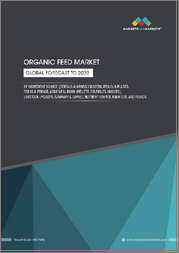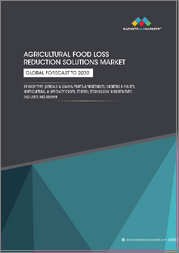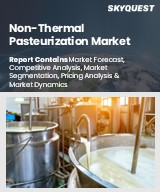
|
시장보고서
상품코드
1642765
두류 시장 보고서 : 유형별, 최종 용도별, 지역별(2025-2033년)Pulses Market Report by Type (Chick Peas, Kaspa Peas, Lentils, Pigeon Peas, Fava Beans, Black Gram, Mung Beans, and Others), End Use (Home Use, Snack Food Industry, Flour Industry), and Region 2025-2033 |
||||||
세계의 두류 시장 규모는 2024년 998억 달러에 달했습니다. IMARC Group은 향후 시장이 2033년까지 1,355억 달러에 이를 전망이며, 2025년부터 2033년까지 3.46%의 성장률(CAGR)을 나타낼 것으로 예측했습니다. 두류의 건강과 영양면에서의 이점에 대한 의식의 고조, 세계의 인구 증가, 공급망의 개선, 농업 활동의 진보, 식생활의 변화, 두류의 요리에 대한 다양성 등이 시장을 추진하고 있는 주요 요인입니다.
렌틸콩, 병아리 콩, 건조 완두콩을 포함한 두류는 콩과 식물의 식용 씨앗입니다. 식물성 단백질,식이 섬유, 철, 아연, 비타민 B 그룹과 같은 필수 영양소의 중요한 공급원입니다. 저지방 및 콜레스테롤이 없는 두류는 심장 건강에 좋고 혈당를 조절하는 데 도움이 됩니다. 식이 섬유가 풍부하기 때문에 포만감을 얻을 수 있으며 체중 관리에도 도움이 됩니다. 또한 두류는 다른 단백질원에 비해 물이나 비료가 적어 환경적으로 지속 가능합니다. 또한 두류는 토양의 질소를 고정시킬 수 있기 때문에 토양의 건강 상태를 향상시킬 수 있습니다.
건강상의 이점과 영양가에 대한 의식이 높아짐에 따라 바이오 강화와 정밀 농업과 같은 진보와 시너지가 되어 두류 시장을 전진시키고 있습니다. 게다가 식물성 단백질에 대한 수요 증가와 지속가능하고 영양이 풍부한 식량 공급원의 부족은 세계 식생활에서 고품질의 두류의 필요성을 강조합니다. 이에 따라 이 두류는 식생활의 다양성을 높이고 필수 영양소의 요구를 충족시키는 데 도움이 되고, 건전한 식물성 선택에 대한 소비자의 기대 증가와 일치하고 있습니다. 또한, 전자상거래 플랫폼의 확대와 식품 폐기물 감소에 대한 노력이 시장 성장에 기여하고 있습니다. 식생활 패턴의 변화, 편리하고 빨리 조리할 수 있는 옵션에의 기울기, 유기 및 비유전자 재조합 제품에 대한 주목 등 다른 요인도, 세계에서 두류의 성장을 뒷받침하고 있습니다.
두류 시장 동향 및 촉진요인 :
건강 의식 증가
건강 및 웰빙에 대한 인식 증가는 국내에서 두류 시장의 성장을 뒷받침하는 중요한 요소입니다. 단백질, 식이 섬유, 필수 영양소를 풍부하게 포함하는 두류는 식생활 개선을 목표로 소비자에게 최적의 선택이 되고 있습니다. 생활습관병의 이환율이 상승을 계속하는 가운데, 건강 목표를 달성하기 위한 영양가가 높고 합리적인 수단으로서, 두류에 주목하고 있습니다. 이러한 건강지향의 고조에 따라, 두류는 헬스케어 부담의 경감과 시민의 생활의 질의 향상을 목표로 하는 국가 전략에 있어서 필수적인 요소가 되고 있습니다.
정부의 지원 및 프로그램
지속가능한 농업과 건강한 식생활을 장려하기 위한 정부의 이니셔티브는 두류 시장의 확대에 기여하고 있습니다. 농가에게 두류 재배 장려금을 제공하는 프로그램과 두류의 영양적 이점에 관한 일반용 계몽 캠페인이 두류 작물의 보급으로 이어지고 있습니다. 이러한 정부의 이니셔티브는 농업 부문을 현대화할 뿐만 아니라 식량 안보와 지속가능한 농업을 촉진하기 위한 국제적인 이니셔티브와도 일치합니다.
급속한 사회 경제 변화
동국의 급속한 경제 성장과 도시개발에 의해 두류를 원료로 하는 제품에 새로운 기회가 탄생하고 있습니다. 도시의 확대와 라이프 스타일의 변화에 따라 편리하고 건강한 식품에 대한 수요가 높아지고 있습니다. 두류는 조리된 식품부터 영양 강화 식품에 이르기까지 다양한 식품에 이용되어 전통적인 소비자의 기호와 신흥 소비자의 기호에 대응하고 있습니다. 두류는 만능이기 때문에 다양한 요리 용도에 적합하며 국가 개발 목표에 부합합니다. 또한 두류는 커뮤니티 가든에서 대규모 농업에 이르기까지 도시계획에서 지속가능한 선택으로 여겨지고 있으며, 인구 증가를 지원할 수 있는 강인하고 지속가능한 도시를 건설하는 목표에 합치하고 있습니다.
목차
제1장 서문
제2장 조사 범위 및 조사 방법
- 조사의 목적
- 이해관계자
- 데이터 소스
- 1차 정보
- 2차 정보
- 시장 추정
- 상향식 접근
- 하향식 접근
- 조사 방법
제3장 주요 요약
제4장 서문
- 개요
- 주요 업계 동향
제5장 세계의 두류 시장
- 시장 개요
- 시장 실적
- 수량 동향
- 금액 동향
- COVID-19의 영향
- 가격 분석
- 주요 가격 지표
- 가격구조
- 가격 동향
- 시장 내역 : 지역별
- 시장 내역 : 유형별
- 시장 내역 : 최종 용도별
- 시장 예측
- 무역 데이터
- 수입 : 주요 국가별
- 수출 : 주요 국가별
- SWOT 분석
- 개요
- 강점
- 약점
- 기회
- 위협
- 밸류체인 분석
- 입력 공급자
- 농민
- 수집가
- 프로세서
- 리셀러
- 수출업체
- 소매업체
- 최종 사용자
- Porter's Five Forces 분석
- 개요
- 구매자의 협상력
- 공급기업의 협상력
- 경쟁도
- 신규 참가업체의 위협
- 대체품의 위협
- 시장 성장 촉진요인 및 성공 요인
제6장 주요 지역의 실적
- 인도
- 시장 동향
- 시장 예측
- 캐나다
- 시장 동향
- 시장 예측
- 미얀마
- 시장 동향
- 시장 예측
- 중국
- 시장 동향
- 시장 예측
- 브라질
- 시장 동향
- 시장 예측
- 기타
- 시장 동향
- 시장 예측
제7장 유형별 시장
- 병아리콩
- 시장 동향
- 시장 예측
- 카스파 피즈
- 시장 동향
- 시장 예측
- 렌틸콩
- 시장 동향
- 시장 예측
- 비둘기 완두콩
- 시장 동향
- 시장 예측
- 누에콩
- 시장 동향
- 시장 예측
- 블랙그램
- 시장 동향
- 시장 예측
- 녹두
- 시장 동향
- 시장 예측
- 기타
- 시장 동향
- 시장 예측
제8장 최종 용도별 시장
- 가정
- 시장 동향
- 시장 예측
- 스낵 식품업계
- 시장 동향
- 시장 예측
- 분말 산업
- 시장 동향
- 시장 예측
- 기타
- 시장 동향
- 시장 예측
제9장 경쟁 구도
- 시장 구조
- 주요 기업
제10장 펄스 처리
- 제품 개요
- 상세한 프로세스 흐름
- 다양한 유형의 단위 조작
- 매스 밸런스와 원재료 요건
- 렌틸콩
- 병아리콩
- 녹두
- 블랙그램
- 비둘기 완두콩
- 누에콩
- 카스파 피즈
제11장 프로젝트의 상세, 필요조건 및 비용
- 토지 요건 및 비용
- 건설 요건 및 비용
- 공장의 기계
- 기계 사진
- 원재료 요건 및 지출
- 원재료 및 최종 제품의 사진
- 포장 요건 및 지출
- 운송 요건 및 지출
- 유틸리티 요건 및 지출
- 인원 요건 및 지출
- 기타 설비투자
제12장 대출 및 자금 지원
제13장 프로젝트의 경제성
- 프로젝트의 자본 비용
- 기술 경제적 파라미터
- 공급망의 각 단계에서 제품 가격 및 마진
- 과세 및 감가상각
- 수입 예측
- 지출 예측
- 재무 분석
- 이익 분석
The global pulses market size reached USD 99.8 Billion in 2024. Looking forward, IMARC Group expects the market to reach USD 135.5 Billion by 2033, exhibiting a growth rate (CAGR) of 3.46% during 2025-2033. The increasing awareness of the health and nutritional benefits of pulses, global population growth, supply chain improvements, advancements in agricultural activities, dietary shifts and the culinary versatility of pulses are some of the major factors propelling the market.
Pulses, including lentils, chickpeas, and dry peas, are the edible seeds of legume plants. They are a significant source of plant-based protein, fiber, and essential nutrients like iron, zinc, and B-vitamins. Characterized by their low-fat content and lack of cholesterol, pulses are beneficial for heart health and can aid in regulating blood sugar levels. Their high fiber content contributes to a feeling of fullness, which can be advantageous in weight management. Additionally, pulses are environmentally sustainable, requiring less water and fertilizer compared to other protein sources. They are also capable of fixing nitrogen in the soil, thereby improving soil health.
The increasing awareness about health benefits and nutritional value is synergizing with advancements like bio-fortification and precision agriculture to propel the pulses market forward. Moreover, the growing demand for plant-based proteins and the scarcity of sustainable, nutrient-rich food sources have emphasized the need for quality pulses in the global diet. In line with this, these pulses are instrumental in enhancing dietary diversity and fulfilling essential nutrient requirements, aligning with rising consumer expectations for wholesome plant-based options. Furthermore, the expansion of e-commerce platforms and initiatives to reduce food waste are contributing to market growth. Other factors such as changing dietary patterns, the inclination towards convenient, ready-to-cook options, and an acute focus on organic and non-GMO products are bolstering the growth of the pulses across the globe.
Pulses Market Trends/Drivers:
Increasing Health Consciousness
The growing awareness of health and wellness is a key factor propelling the market growth for pulses in the country. Rich in protein, fiber, and essential nutrients, pulses are becoming the go-to choice for consumers seeking to improve their dietary habits. As rates of lifestyle diseases continue to rise, individuals are turning to pulses as a nutritious and affordable means to achieve their health goals. This growing focus on wellness makes pulses an essential element of national strategies aimed at reducing healthcare burdens and enhancing citizens' quality of life.
Governmental Support and Programs
Government initiatives aimed at encouraging sustainable agriculture and healthy eating are contributing to the pulse market's expansion. Programs that offer farmers incentives for pulse cultivation, alongside public awareness campaigns on the nutritional benefits of pulses, are leading to increased adoption of these crops. Such governmental actions not only modernize the agricultural sector but also align with international efforts aimed at promoting food security and sustainable farming practices.
Rapid Socioeconomic Changes
The country's swift economic growth and urban development are creating new opportunities for pulse-based products. As urban areas expand and lifestyles change, there is increasing demand for convenient and healthy food options. Pulses are finding their way into a range of food products, from ready-to-eat meals to fortified foods, serving both traditional and emerging consumer preferences. Their versatile nature makes them apt for diverse culinary applications, thereby matching the nation's development objectives. In addition, pulses are seen as a sustainable choice in urban planning, from community gardens to large-scale farming, aligning with the goal of building resilient and sustainable cities capable of supporting a growing population.
Pulses Industry Segmentation:
Breakup by Type:
Chick Peas
Kaspa Peas
Lentils
Pigeon Peas
Fava Beans
Black Gram
Mung Beans
Others
Kaspa peas dominate the market
Kaspa peas, also known as Kaspa beans or Lablab beans, are indeed a type of pulses that holds significance in the market. Pulses are a subgroup of legumes, and Kaspa peas are no exception. They are popular in various cuisines and are valued for their nutritional content, which includes protein, fiber, vitamins, and minerals. These yellow peas are commonly used for their creamy texture in a range of dishes, from classic pea soup to innovative plant-based protein products. They are also gaining popularity in specialized applications like gluten-free baking, where their flour form serves as an excellent alternative to traditional wheat flour. Kaspa peas offer a rich source of nutrients for specific dietary needs, such as in high-protein, low-fat meals and snacks. Innovative food tech solutions, including the development of pea-based protein powders and meat alternatives, are allowing consumers to incorporate Kaspa peas into their diets more conveniently. These trends not only provide diverse and nutritious options for consumption but also align with broader goals of sustainable and healthy living. These multiple roles solidify Kaspa peas as an essential component in modern culinary practices, reflecting market research companies' insights into evolving food trends and applications.
Breakup by End Use:
Home use
Snack Food Industry
Flour Industry
Home use holds the largest share in the market
Home use as an end-use segment for the pulses market is a significant and vital component of the overall pulse consumption landscape. Pulses, which include various legumes like lentils, chickpeas, and beans, have been a staple in diets across the globe for centuries. Home consumption of pulses serves as a fundamental source of nutrition and sustenance for countless households. Pulses are renowned for their high protein content, making them an essential dietary component, especially for vegetarians and vegans. They are also rich in fiber, vitamins, and minerals, contributing to a balanced and nutritious diet. Many cultures have deep-rooted traditions of incorporating pulses into their culinary heritage. This tradition has been passed down through generations, highlighting the cultural significance of pulses in home cooking.
Breakup by Country:
India
Canada
Myanmar
China
Brazil
Others
India holds the largest share in the market
The increasing emphasis on nutritious and plant-based diets in India is acting as a significant driver for the pulses market. Concurrently, advancements in agricultural techniques are leading to higher yield varieties of pulses, thereby boosting their market availability. Additionally, the expanding middle class in the country is showing a growing preference for diverse, protein-rich foods like pulses. Online grocery platforms are also playing a role, making a wide variety of pulses more accessible to the general populace, thus positively impacting market dynamics. The rising focus on sustainable farming practices is drawing attention to pulses as they are known to enrich soil with essential nutrients, aligning with the government's sustainability objectives and enhancing the market landscape. Events such as food and agriculture expos, as well as online webinars on nutrition and sustainability, are cumulatively contributing to a vibrant growth outlook for the pulses market in India.
Competitive Landscape:
In the global pulses market, leading firms are actively employing a range of strategies to assert their market dominance and address the changing needs of consumers. These companies are heavily investing in research and development to cultivate new pulse varieties that offer enhanced nutritional profiles, shorter growing cycles, and better resistance to diseases. Collaborations with local farmers and agricultural bodies are being forged to guarantee a wide-reaching supply chain that spans multiple geographies. Additionally, comprehensive marketing efforts are underway to enlighten both consumers and industries about the health advantages and sustainability of incorporating pulses into diets and products. Some of these market leaders are even committing resources to establish or upgrade processing facilities, thus boosting local economies and providing employment opportunities. Partnerships with governmental agencies and endorsements from health organizations are solidifying their stand on adhering to quality standards and sustainable farming practices. These key players are also embracing technological advancements like blockchain for transparent sourcing and artificial intelligence for predictive yield analysis. Through a judicious mix of innovation, consumer education, strategic alliances, and sustainability initiatives, these firms are fortifying their standing in the global pulses market.
The report has provided a comprehensive analysis of the competitive landscape in the market. Detailed profiles of all major companies have also been provided. Some of the key players in the market include:
Adani Wilmar Limited.
Globeways Canada, Inc.
BroadGrain Commodities Inc.
NHC Adani Foods Limited
AGT Food and Ingredients
Louis Dreyfus
Goya Food Inc.
Key Questions Answered in This Report
- 1. What was the size of the global pulses market in 2024?
- 2. What is the expected growth rate of the global pulses market during 2025-2033?
- 3. What are the key factors driving the global pulses market?
- 4. What has been the impact of COVID-19 on the global pulses market?
- 5. What is the breakup of the global pulses market based on the type?
- 6. What is the breakup of the global pulses market based on the end-use?
- 7. What are the key regions in the global pulses market?
Table of Contents
1 Preface
2 Scope and Methodology
- 2.1 Objectives of the Study
- 2.2 Stakeholders
- 2.3 Data Sources
- 2.3.1 Primary Sources
- 2.3.2 Secondary Sources
- 2.4 Market Estimation
- 2.4.1 Bottom-Up Approach
- 2.4.2 Top-Down Approach
- 2.5 Forecasting Methodology
3 Executive Summary
4 Introduction
- 4.1 Overview
- 4.2 Key Industry Trends
5 Global Pulses Market
- 5.1 Market Overview
- 5.2 Market Performance
- 5.2.1 Volume Trends
- 5.2.2 Value Trends
- 5.3 Impact of COVID-19
- 5.4 Price Analysis
- 5.4.1 Key Price Indicators
- 5.4.2 Price Structure
- 5.4.3 Price Trends
- 5.5 Market Breakup by Region
- 5.6 Market Breakup by Type
- 5.7 Market Breakup by End-Use
- 5.8 Market Forecast
- 5.9 Trade Data
- 5.9.1 Imports by Major Countries
- 5.9.2 Exports by Major Countries
- 5.10 SWOT Analysis
- 5.10.1 Overview
- 5.10.2 Strengths
- 5.10.3 Weaknesses
- 5.10.4 Opportunities
- 5.10.5 Threats
- 5.11 Value Chain Analysis
- 5.11.1 Input Suppliers
- 5.11.2 Farmers
- 5.11.3 Collectors
- 5.11.4 Processors
- 5.11.5 Distributors
- 5.11.6 Exporters
- 5.11.7 Retailers
- 5.11.8 End-Users
- 5.12 Porter's Five Forces Analysis
- 5.12.1 Overview
- 5.12.2 Bargaining Power of Buyers
- 5.12.3 Bargaining Power of Suppliers
- 5.12.4 Degree of Competition
- 5.12.5 Threat of New Entrants
- 5.12.6 Threat of Substitutes
- 5.13 Key Market Drivers and Success Factors
6 Performance of Key Regions
- 6.1 India
- 6.1.1 Market Trends
- 6.1.2 Market Forecast
- 6.2 Canada
- 6.2.1 Market Trends
- 6.2.2 Market Forecast
- 6.3 Myanmar
- 6.3.1 Market Trends
- 6.3.2 Market Forecast
- 6.4 China
- 6.4.1 Market Trends
- 6.4.2 Market Forecast
- 6.5 Brazil
- 6.5.1 Market Trends
- 6.5.2 Market Forecast
- 6.6 Others
- 6.6.1 Market Trends
- 6.6.2 Market Forecast
7 Market by Type
- 7.1 Chick Peas
- 7.1.1 Market Trends
- 7.1.2 Market Forecast
- 7.2 Kaspa Peas
- 7.2.1 Market Trends
- 7.2.2 Market Forecast
- 7.3 Lentils
- 7.3.1 Market Trends
- 7.3.2 Market Forecast
- 7.4 Pigeon Peas
- 7.4.1 Market Trends
- 7.4.2 Market Forecast
- 7.5 Fava Beans
- 7.5.1 Market Trends
- 7.5.2 Market Forecast
- 7.6 Black Gram
- 7.6.1 Market Trends
- 7.6.2 Market Forecast
- 7.7 Mung Beans
- 7.7.1 Market Trends
- 7.7.2 Market Forecast
- 7.8 Others
- 7.8.1 Market Trends
- 7.8.2 Market Forecast
8 Market by End-Use
- 8.1 Home Use
- 8.1.1 Market Trends
- 8.1.2 Market Forecast
- 8.2 Snack Food Industry
- 8.2.1 Market Trends
- 8.2.2 Market Forecast
- 8.3 Flour Industry
- 8.3.1 Market Trends
- 8.3.2 Market Forecast
- 8.4 Others
- 8.4.1 Market Trends
- 8.4.2 Market Forecast
9 Competitive Structure
- 9.1 Market Structure
- 9.2 Key Players
10 Pulses Processing
- 10.1 Product Overview
- 10.2 Detailed Process Flow
- 10.3 Various Types of Unit Operations Involved
- 10.4 Mass Balance and Raw Material Requirements
- 10.4.1 Lentils
- 10.4.2 Chick Peas
- 10.4.3 Mung Beans
- 10.4.4 Black Gram
- 10.4.5 Pigeon Peas
- 10.4.6 Fava Beans
- 10.4.7 Kaspa Peas
11 Project Details, Requirements and Costs Involved
- 11.1 Land Requirements and Expenditures
- 11.2 Construction Requirements and Expenditures
- 11.3 Plant Machinery
- 11.4 Machinery Pictures
- 11.5 Raw Material Requirements and Expenditures
- 11.6 Raw Material and Final Product Pictures
- 11.7 Packaging Requirements and Expenditures
- 11.8 Transportation Requirements and Expenditures
- 11.9 Utility Requirements and Expenditures
- 11.10 Manpower Requirements and Expenditures
- 11.11 Other Capital Investments
12 Loans and Financial Assistance
13 Project Economics
- 13.1 Capital Cost of the Project
- 13.2 Techno-Economic Parameters
- 13.3 Product Pricing and Margins Across Various Levels of the Supply Chain
- 13.4 Taxation and Depreciation
- 13.5 Income Projections
- 13.6 Expenditure Projections
- 13.7 Financial Analysis
- 13.8 Profit Analysis

















